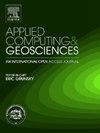Predictive regressive models of recent marsh sediment thickness improve the quantification of coastal marsh sediment budgets
IF 3.2
Q2 COMPUTER SCIENCE, INTERDISCIPLINARY APPLICATIONS
引用次数: 0
Abstract
Coastal marsh wetlands experience variations in vertical gains and losses through time, which have allowed them to infill relict topography and record variations in drivers. The stratigraphic unit associated with the development of the marsh also reflects the long-term importance of key ecosystem services supplied by the marsh environment, including carbon storage and storm mitigation. Mapping these coastal wetland sediments and the marsh unit thickness is challenging as traditional coastal geophysical tools are not easily deployable (acoustic methods) or are unreliable in saline-soil environments (e.g., ground-penetrating radar), leaving core-based methods the most viable mapping method. In the present study, we utilized prior information on the geologic architecture of the region to select spatial and physical metrics that likely persisted throughout evolution of the marsh during the late Holocene. We then assessed the individual and collective power of these metrics to predict marsh thickness observed from cores. Employing regressive predictive models powered by these data, we improve the quantification of marsh thickness for a coastal fringing marsh within the Grand Bay estuary in Mississippi and Alabama (USA). The information gained from this approach yields improved estimates of the carbon stocks in this environment. Additionally, the stored sediment masses reflect the past, and potential future, persistence of the Grand Bay marsh under historical and present marsh-estuarine sediment exchange fluxes. Such improvements to both the sediment budget of recent marsh stratigraphic units and the spatial extent provide new resources for comparison with large-scale landscape models, the latter of which may be used, when validated, to predict future change and ecosystem transformations.
近期沼泽沉积物厚度的预测回归模型改进了沿海沼泽沉积物收支的量化
随着时间的推移,沿海沼泽湿地的垂直收益和损失会发生变化,这使它们能够填补遗留的地形并记录驱动因素的变化。与沼泽发展有关的地层单位也反映了沼泽环境提供的关键生态系统服务的长期重要性,包括碳储存和减缓风暴。绘制这些沿海湿地沉积物和沼泽单位厚度具有挑战性,因为传统的沿海地球物理工具不容易部署(声学方法),或者在盐碱地环境中不可靠(例如,探地雷达),因此基于岩心的方法是最可行的制图方法。在本研究中,我们利用该地区地质结构的先验信息来选择可能在全新世晚期沼泽进化过程中持续存在的空间和物理指标。然后,我们评估了这些指标的个人和集体能力,以预测从岩心观察到的沼泽厚度。利用这些数据支持的回归预测模型,我们改进了密西西比州和阿拉巴马州大湾河口沿海边缘沼泽厚度的量化。通过这种方法获得的信息可以改进对该环境中碳储量的估计。此外,储存的沉积物质量反映了历史和现在的沼泽-河口沉积物交换通量下大湾沼泽的过去和潜在的未来持续性。这种对近期沼泽地层单元的泥沙收支和空间范围的改进为与大尺度景观模型的比较提供了新的资源,后者在得到验证后可用于预测未来的变化和生态系统的转变。
本文章由计算机程序翻译,如有差异,请以英文原文为准。
求助全文
约1分钟内获得全文
求助全文
来源期刊

Applied Computing and Geosciences
Computer Science-General Computer Science
CiteScore
5.50
自引率
0.00%
发文量
23
审稿时长
5 weeks
 求助内容:
求助内容: 应助结果提醒方式:
应助结果提醒方式:


